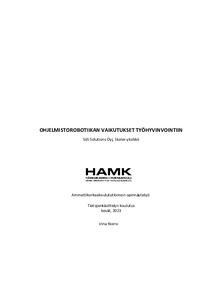Ohjelmistorobotiikka ja sen vaikutukset työhyvinvointiin
Norro, Irina (2023)
Norro, Irina
2023
All rights reserved. This publication is copyrighted. You may download, display and print it for Your own personal use. Commercial use is prohibited.
Julkaisun pysyvä osoite on
https://urn.fi/URN:NBN:fi:amk-2023060521436
https://urn.fi/URN:NBN:fi:amk-2023060521436
Tiivistelmä
Opinnäytetyön tarkoituksena oli tarkastella ohjelmistorobotiikan (Robotic Process Automation, RPA) merkitystä työhyvinvointiin ja sen mahdollista vaikutusta työtehtävien mielekkyyteen työtehtävien automatisoinnin kautta. Tutkimuksessa suoritettiin ohjelmistorobotiikan kehitystyö tilaajayrityksen, Siili Solutions Oyj:n tarpeisiin sekä tutkimus, jossa vertailtiin työntekijöiden työhyvinvointia ennen ja jälkeen automaation käyttöönoton. Opinnäytetyöni tutkii, voiko RPA tarjota yrityksille kilpailuetua parantamalla työntekijöiden hyvinvointia.
Opinnäytetyön tietopohja koostuu RPAn ja työhyvinvoinnin määrittelystä ja lisäksi siinä avataan aikaisempia tutkimuksia vaikutuksista työhyvinvointiin. Teoreettisessa osuudessa kuvaan myös RPAn suunnittelua ja kehitystä. Opinnäytetyössä on kaksi osaa, toiminnallisessa osassa ohjelmoidaan ohjelmistorobotti tilaajayrityksen sisäisiin tarpeisiin. Tutkimuksellisessa osassa tutkimusmetodina käytettiin kyselyitä ja niiden avulla vertaillaan henkilöstön työhyvinvointia ennen automaation käyttöönottoa ja sen jälkeen.
Tutkimuksen tulokset osoittivat, että työhyvinvointiin liittyvien tekijöiden arvosanat olivat hyvällä tasolla molemmissa kyselyissä, mutta hieman laskua havaittiin automaation jälkeen. Tulevaisuudessa voisi olla hyödyllistä pitemmän aikavälin seurannassa, jotta saataisiin yleistettävämpiä tuloksia. Positiivisena asiana voidaan pitää myös sitä, että kyselyyn osallistuneista 75 % koki työkuvansa mielekkäämmäksi automatisoinnin myötä. Kyselyistä saadut kokemukset ovat sellaisenaan hyödynnettävissä yrityksessä. Toiminnallisessa osassa luotu ohjelmistorobotti on liiketoimintakriittinen ja siitä on suoraa hyötyä tilaajayritykselle.
Avainsanat ohjelmistorobotiikka, ohjelmistorobotti, työhyvinvointi
Sivut 68 sivua ja liitteitä 11 sivua The purpose of this thesis was to examine the significance of Robotic Process Automation (RPA) on employee well-being and its possible impact on the meaningfulness of tasks through task automation. The study carried out RPA development work for the needs of the client company, Siili Solutions Oyj, as well as a study comparing employee well-being before and after the implementation of automation. My thesis investigates whether RPA can provide companies with a competitive advantage by improving employee well-being.
The information base of the thesis consists of defining RPA and well-being at work and presenting previous studies on the effects on well-being at work. In the theoretical part, my thesis also describes the design and development of RPA. The thesis has two parts, in the functional part, a software robot is programmed for the internal needs of the client company. In the research part, surveys were used as a research method, and they were used to compare the well-being of staff before and after the introduction of automation.
The results of the study showed that the scores related to well-being at work were at a good level in both surveys, but a slight decrease was observed after automation. In the future, it might be beneficial to have a longer-term follow-up to get more generalizable results. A positive aspect is also that 75% of the respondents felt their work was more meaningful after automation. The experiences gained from inquiries can be directly utilized within the company. The software robot created in the functional part is business-critical and is of direct benefit to the client company.
Keywords Robotic process automation, robot, employee well-being
Pages 68 pages and appendices 11 pages
Opinnäytetyön tietopohja koostuu RPAn ja työhyvinvoinnin määrittelystä ja lisäksi siinä avataan aikaisempia tutkimuksia vaikutuksista työhyvinvointiin. Teoreettisessa osuudessa kuvaan myös RPAn suunnittelua ja kehitystä. Opinnäytetyössä on kaksi osaa, toiminnallisessa osassa ohjelmoidaan ohjelmistorobotti tilaajayrityksen sisäisiin tarpeisiin. Tutkimuksellisessa osassa tutkimusmetodina käytettiin kyselyitä ja niiden avulla vertaillaan henkilöstön työhyvinvointia ennen automaation käyttöönottoa ja sen jälkeen.
Tutkimuksen tulokset osoittivat, että työhyvinvointiin liittyvien tekijöiden arvosanat olivat hyvällä tasolla molemmissa kyselyissä, mutta hieman laskua havaittiin automaation jälkeen. Tulevaisuudessa voisi olla hyödyllistä pitemmän aikavälin seurannassa, jotta saataisiin yleistettävämpiä tuloksia. Positiivisena asiana voidaan pitää myös sitä, että kyselyyn osallistuneista 75 % koki työkuvansa mielekkäämmäksi automatisoinnin myötä. Kyselyistä saadut kokemukset ovat sellaisenaan hyödynnettävissä yrityksessä. Toiminnallisessa osassa luotu ohjelmistorobotti on liiketoimintakriittinen ja siitä on suoraa hyötyä tilaajayritykselle.
Avainsanat ohjelmistorobotiikka, ohjelmistorobotti, työhyvinvointi
Sivut 68 sivua ja liitteitä 11 sivua
The information base of the thesis consists of defining RPA and well-being at work and presenting previous studies on the effects on well-being at work. In the theoretical part, my thesis also describes the design and development of RPA. The thesis has two parts, in the functional part, a software robot is programmed for the internal needs of the client company. In the research part, surveys were used as a research method, and they were used to compare the well-being of staff before and after the introduction of automation.
The results of the study showed that the scores related to well-being at work were at a good level in both surveys, but a slight decrease was observed after automation. In the future, it might be beneficial to have a longer-term follow-up to get more generalizable results. A positive aspect is also that 75% of the respondents felt their work was more meaningful after automation. The experiences gained from inquiries can be directly utilized within the company. The software robot created in the functional part is business-critical and is of direct benefit to the client company.
Keywords Robotic process automation, robot, employee well-being
Pages 68 pages and appendices 11 pages
